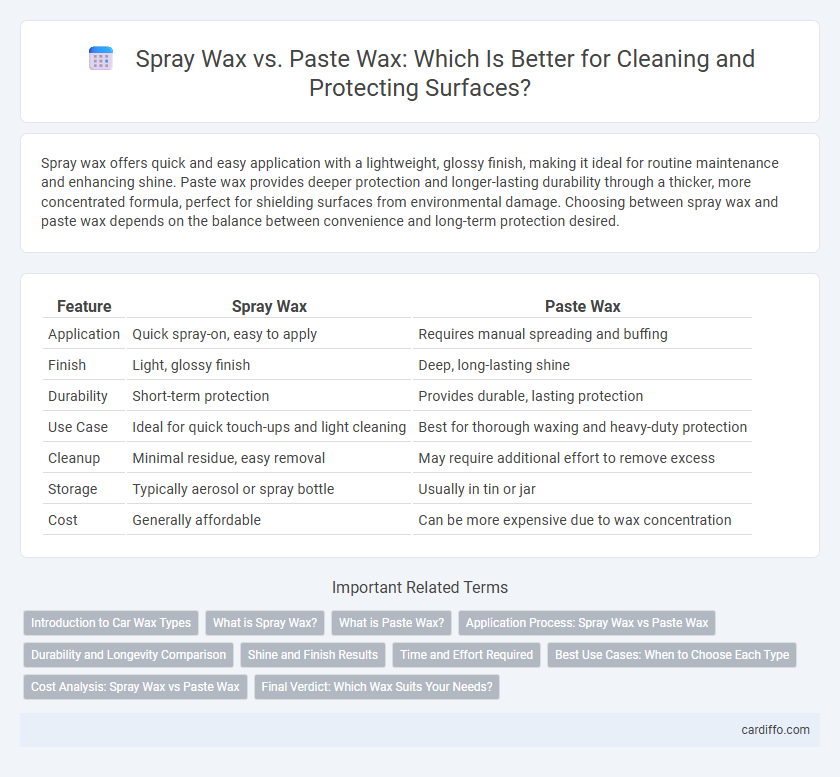Spray wax offers quick and easy application with a lightweight, glossy finish, making it ideal for routine maintenance and enhancing shine. Paste wax provides deeper protection and longer-lasting durability through a thicker, more concentrated formula, perfect for shielding surfaces from environmental damage. Choosing between spray wax and paste wax depends on the balance between convenience and long-term protection desired.
Table of Comparison
| Feature | Spray Wax | Paste Wax |
|---|---|---|
| Application | Quick spray-on, easy to apply | Requires manual spreading and buffing |
| Finish | Light, glossy finish | Deep, long-lasting shine |
| Durability | Short-term protection | Provides durable, lasting protection |
| Use Case | Ideal for quick touch-ups and light cleaning | Best for thorough waxing and heavy-duty protection |
| Cleanup | Minimal residue, easy removal | May require additional effort to remove excess |
| Storage | Typically aerosol or spray bottle | Usually in tin or jar |
| Cost | Generally affordable | Can be more expensive due to wax concentration |
Introduction to Car Wax Types
Spray wax offers quick application and a lightweight, glossy finish, making it ideal for routine car maintenance and enhancing shine between washes. Paste wax provides a thicker, more durable protective layer, often formulated with natural carnauba, ensuring long-lasting defense against environmental elements. Choosing between spray and paste wax depends on the desired balance between convenience and durability in car detailing.
What is Spray Wax?
Spray wax is a liquid car care product designed for quick application and fast drying, providing a glossy finish and protective barrier against dirt and water. It contains polymers and carnauba wax that enhance shine while offering easy maintenance compared to paste wax. Ideal for regular touch-ups, spray wax requires minimal effort and does not need buffing for effective surface protection.
What is Paste Wax?
Paste wax is a traditional polishing product composed of natural or synthetic waxes, such as carnauba or beeswax, combined with solvents and sometimes abrasives to provide a durable protective layer on surfaces like wood, metal, and automobiles. It offers a thicker, more long-lasting finish that enhances shine while filling in minor imperfections, making it ideal for deep preservation and a high-gloss appearance. Unlike spray wax, paste wax requires application with a cloth or applicator pad and buffing to achieve optimal results.
Application Process: Spray Wax vs Paste Wax
Spray wax offers a quick and easy application process, allowing for an even coat with minimal effort, ideal for regular maintenance and touch-ups. Paste wax requires more time and skill, involving application with a cloth or applicator pad followed by buffing to achieve a deep, durable shine. While spray wax provides convenience and speed, paste wax delivers longer-lasting protection and a richer finish, making the choice dependent on desired results and time investment.
Durability and Longevity Comparison
Spray wax offers quick application and a glossy finish but typically provides less durability, often lasting only a few weeks under regular conditions. Paste wax, composed of natural or synthetic ingredients, forms a thicker protective layer that can endure several months, resisting water and environmental contaminants more effectively. For long-term protection and sustained shine, paste wax is preferred due to its superior longevity and durability compared to spray wax.
Shine and Finish Results
Spray wax provides a quick, high-gloss shine with a lightweight, smooth finish ideal for daily maintenance and easy application. Paste wax offers a deeper, more durable finish that enhances paint protection and produces a richer, long-lasting shine, making it preferable for detailed polishing. Choosing between spray and paste wax depends on the desired balance of convenience versus longevity in shine and finish results.
Time and Effort Required
Spray wax requires significantly less time and effort compared to paste wax, as it can be quickly applied and buffed on without the need for extensive rubbing or waiting for it to dry. Paste wax involves a more labor-intensive process, requiring careful application, drying time, and thorough buffing to achieve a durable shine. For quick touch-ups or routine maintenance, spray wax is ideal, while paste wax suits deeper protection with a higher time investment.
Best Use Cases: When to Choose Each Type
Spray wax is best suited for quick application and light protection on recently washed vehicles, ideal for maintaining shine between thorough washes. Paste wax provides deeper protection and durability, making it the preferred choice for older paint or vehicles exposed to harsh environmental conditions. For regular, fast maintenance, spray wax is efficient, whereas paste wax excels in long-lasting defense and restoration.
Cost Analysis: Spray Wax vs Paste Wax
Spray wax typically offers a lower upfront cost and faster application, making it ideal for quick maintenance and frequent use. Paste wax, while more expensive initially, provides longer-lasting protection and better durability, reducing the need for frequent reapplication and offering cost savings over time. Evaluating cost per use reveals that paste wax is more economical for long-term care, whereas spray wax suits budget-conscious users seeking convenience.
Final Verdict: Which Wax Suits Your Needs?
Spray wax offers quick application and a lightweight finish ideal for routine maintenance and enhancing shine on smooth surfaces. Paste wax provides a more durable, long-lasting protective layer, better suited for deep protection and restoration on older or heavily used finishes. Choosing between spray and paste wax depends on your specific cleaning frequency, desired protection level, and surface condition.
Spray wax vs Paste wax Infographic

 cardiffo.com
cardiffo.com